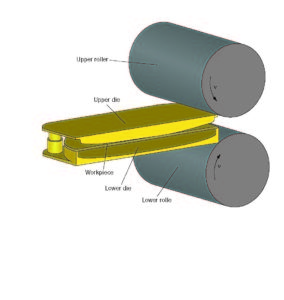 Some researchers have presented the results of the Finite Element Modelling of a new combined process (Plate Rolling and Stamping). This process has been used to produce big-size bodies, for instance like the bottom of a vacuum container, the lower part of a ladle furnace and so on. Traditionally, such products (with upper wall thickness of 40 mm and maximum diameter width of 4000 mm) are produced in engineering companies that use stamping processes. Various implementation schemes of the present combined process have been investigated. The new combined process method for the production of rotating bodies (without using pressurized equipment) have been developed. The principle is the rolling of a pack of upper die, lower die and the flat thickness part between the two that is the core of the entire process. The FEM results of the combined rolling and stamping process with the aid of DEFORM 3D software have demonstrated that the main problems of the process are the fixity loss of the pack while rolling and the corresponding defects under the form of folds, increasing the consumption index and the manufacturing cost. The research and the 3D modelling of the two methods of the combined rolling process have been carried out. The 3D analysis highlighted that the deformation level is positioned close to the outer piece surface. A high value of deformation in the combined process emerges with parts having a thickness of 40 mm or higher and it can be critical in relation to discontinuity defects that appear in this zone. They have established that during the rolling method the highest stresses emerge especially on the pack, in particular on the areas of the upper and lower part of dies. Stress levels can reach 1000 MPa. Such high values of tensile stresses are mainly explained by the fact that the piece is hot and the tools (the upper and lower dies, the rolls) are cold, having the same environment temperature. They have established the process parameters (piece heating temperature, its thickness, the deformation speed, friction conditions) for the inverse deformation method. Modelling results have allowed optimizing the shapes of upper and lower dies and also the package implementation, taking into account the rolling and stamping process stability. The advantages and the defects of both combined process methods have been established. The inverse deformation method turned out to be preferable for the practical implementation, from the point of view of both the process stability and of the energy efficiency.
Some researchers have presented the results of the Finite Element Modelling of a new combined process (Plate Rolling and Stamping). This process has been used to produce big-size bodies, for instance like the bottom of a vacuum container, the lower part of a ladle furnace and so on. Traditionally, such products (with upper wall thickness of 40 mm and maximum diameter width of 4000 mm) are produced in engineering companies that use stamping processes. Various implementation schemes of the present combined process have been investigated. The new combined process method for the production of rotating bodies (without using pressurized equipment) have been developed. The principle is the rolling of a pack of upper die, lower die and the flat thickness part between the two that is the core of the entire process. The FEM results of the combined rolling and stamping process with the aid of DEFORM 3D software have demonstrated that the main problems of the process are the fixity loss of the pack while rolling and the corresponding defects under the form of folds, increasing the consumption index and the manufacturing cost. The research and the 3D modelling of the two methods of the combined rolling process have been carried out. The 3D analysis highlighted that the deformation level is positioned close to the outer piece surface. A high value of deformation in the combined process emerges with parts having a thickness of 40 mm or higher and it can be critical in relation to discontinuity defects that appear in this zone. They have established that during the rolling method the highest stresses emerge especially on the pack, in particular on the areas of the upper and lower part of dies. Stress levels can reach 1000 MPa. Such high values of tensile stresses are mainly explained by the fact that the piece is hot and the tools (the upper and lower dies, the rolls) are cold, having the same environment temperature. They have established the process parameters (piece heating temperature, its thickness, the deformation speed, friction conditions) for the inverse deformation method. Modelling results have allowed optimizing the shapes of upper and lower dies and also the package implementation, taking into account the rolling and stamping process stability. The advantages and the defects of both combined process methods have been established. The inverse deformation method turned out to be preferable for the practical implementation, from the point of view of both the process stability and of the energy efficiency.
Source: Alexander Pesin, Ernst Drigunt, Denis Pustovoytov and Ilya Pesin, “Finite Element Modelling of Combined Process of Plate Rolling and Stamping”, The 12th International Conference on Numerical Methods in Industrial Forming Processes – NUMIFORM 2016, University of Technology of Troyes – France, 4-7



